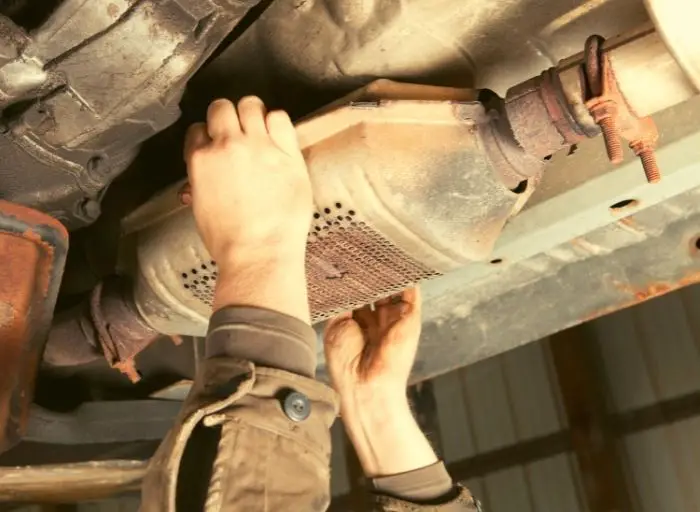
A clogged catalytic converter is a typical problem in high mileage automobiles. Usually between 150kk and 200 kilometers. So, how to tell if a catalytic converter is clogged?
The catalytic converter systems eliminate the car exhaust fume that harms our environment. It is loaded with a chemical catalyst that aids in the conversion of hazardous emissions from the engine into non-damaging gasses. However, the catalytic converter can become blocked at any time, causing your engine to run poorly and providing you an unsatisfactory ride for no apparent reason. As a result, it’s critical to understand how to identify if it’s clogged or not.
Table of Contents
How to Tell if a Catalytic Converter Is Clogged?
Catalytic converters are costly, and you don’t want to risk guessing if something is wrong with them. If you’re still not sure, check out the entire list of symptoms and signs that indicate a clogged catalytic converter below:
#1 The check engine light has turned on
Your body will alert you when your liver is failing, and the engine check light will alert you when something is wrong. If your car was built in 1996 or later, it will be equipped with an onboard diagnostic system that will automatically test the catalytic converter. Air-to-fuel ratio sensors, which assess if your exhaust is spewing too much pollution, can set up the check engine light.
A malfunctioning catalytic converter can also fail as a result of a failure of another automobile component like a spark plug. Make sure to replace any damaged spark plugs and arrange an examination if you suspect a problem.
#2 Starting the engine is difficult
Strong exhaust backpressure can cause the engine to stall by choking it. In the event of severe obstruction, your engine may start and idle for a few minutes before dying. In fact, Catalytic converters can become so clogged that the engine will not even start. The catch is that if you’ve driven it to this point, you’ve most likely already observed low fuel efficiency and engine performance unless you weren’t paying attention.
#3 It’s hotter than normal
The use of an infrared thermometer is another approach to determine if the catalytic converter is clogged. You can measure the temperature of the exhaust pipe before and after the catalytic converter because blocked catalytic converters run hotter. The standard operating temperature is from 1,200 to 1,700 degrees Fahrenheit. However, since the quantity of pollutants in the exhaust pipe increases, so does the working temperature of the catalytic converter.
#4 Fuel efficiency and engine performance are both poor
Your engine won’t be able to breathe properly if your catalytic converter is clogged. As a result, your car’s acceleration and general performance may suffer. You may also experience a decrease in fuel economy.
#5 Fuel efficiency is an issue for you
Have you noticed that your gas mileage isn’t quite as good as it once was? Did it happen all of a sudden? This might be another sign of a failing catalytic converter. Your engine needs to work harder if it doesn’t have enough oxygen. It consumes more fuel the harder it has to work. The more fuel it uses, the fewer miles per gallon it will pull out of your tank.
#6 Emissions test failed
The check engine light can be triggered by blocked catalytic converters, which will lead you to fail an emissions test in most places. Furthermore, if your car’s clogged Catalytic Converters have disintegrated within, it’s unlikely that it’ll clear a tailpipe emissions test.
Clogs can even trigger the catalyst elements to split into bits, as previously described. Hit the catalytic converters a tap and check for rattling noises if you feel you’ve achieved this level of damage. Worse, in some engines, if the honeycomb section of the catalyst starts to break up, catalytic converter particles might enter the cylinders and kill the engine due to the dynamics of exhaust pulses.
NOTE: Some states such as Georgia, New York, Massachusetts, Vermont, and New Hampshire mandate annual safety inspections with an emissions test.
When Should Your Catalytic Converter Be Replaced or Repaired?
A catalytic converter that has become clogged should be changed. You can’t believe everything you read, even if there are items on the market that advertise to be catalytic converter cleaners.
The only method to repair the problem is to replace the clogged catalytic converters. Even in states that don’t test emissions, removing the catalytic converter first and then replacing it with a pipe is a violation of federal law. It’s not a good idea to go there.
Conclusion
Catalytic converters are rarely clogged, and when they are, it’s usually because something is wrong with the car, such as engine misfires or low fuel quality. Make sure you know all the possible signs of a failed catalytic converter system.
Hi there! I’m Naomi O’Colman. I’ve got years of experience working at an auto repair shop here in Texas under my belt. On top of that, ever since I was a kid I’ve been passionate about the auto industry. Since I’ve joined the team at automotivegearz.com I’ve been enthusiastically sharing my passion and insights with my readers. I’m dedicated to delivering high quality content and helping you stay up to date with the latest automotive trends and products out there!







